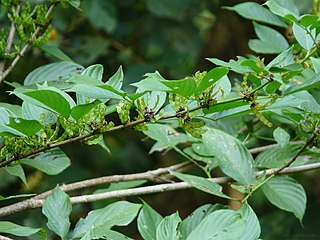
The triquetral bone is located in the wrist on the medial side of the proximal row of the carpus between the lunate and pisiform bones. It is on the ulnar side of the hand, but does not directly articulate with the ulna. Instead, it is connected to and articulates with the ulna through the Triangular fibrocartilage disc and ligament, which forms part of the ulnocarpal joint capsule. It connects with the pisiform, hamate, and lunate bones. It is the 2nd most commonly fractured carpal bone.

Talinum fruticosum is a herbaceous perennial plant that is native to Mexico, the Caribbean, West Africa, Central America, and much of South America. Common names include Ceylon spinach, waterleaf, cariru, Gbure, Surinam purslane, Philippine spinach, Florida spinach, potherb fameflower, Lagos bologi, sweetheart, and Kutu bataw in Ghana from the Akan language It is widely grown in tropical regions as a leaf vegetable.

Heteragrion is a genus of damselflies in the family Heteragrionidae.
Triangular ligament may refer to:

Vasum, common name the vase snails or vase shells, is a genus of mostly rather large predatory sea snails, marine gastropod mollusks in the subfamily Vasinae within the family Turbinellidae.
Llistrofus is an extinct genus of early Permian microsaur within the family Hapsidopareiidae that is known from Oklahoma.

Odonterpeton is an extinct genus of "microsaur" from the Late Carboniferous of Ohio, containing the lone species Odonterpeton triangulare. It is known from a single partial skeleton preserving the skull, forelimbs, and the front part of the torso. The specimen was found in the abandoned Diamond Coal Mine of Linton, Ohio, a fossiliferous coal deposit dated to the late Moscovian stage, about 310 million years ago.

Dendrolobium is a genus of flowering plants in the legume family, Fabaceae. It belongs to the subfamily Faboideae. It includes 21 species of mostly trees and shrubs and rarely herbs. Species range from eastern Africa to Madagascar, India, Indochina, southern China, Malesia, Papuasia, northern and western Australia, and the southwestern Pacific. Typical habitats include seasonally-dry tropical forest and woodland, bamboo thickets, and grassland.
Canistrum triangulare is a plant species in the genus Canistrum. This species is endemic to Brazil.

Recumbirostra is a clade of tetrapods which lived during the Carboniferous and Permian periods. They are thought to have had a fossorial (burrowing) lifestyle and the group includes both short-bodied and long-bodied snake-like forms. At least one species, the long-bodied molgophid Nagini mazonense, lost its forelimbs entirely. Recumbirostra includes the families Pantylidae, Gymnarthridae, Ostodolepidae, Rhynchonkidae and Brachystelechidae, with additional families such as Microbrachidae and Molgophidae being included by some authors. Brachystelechidae and Molgophidae have also been grouped together in the suggested clade Chthonosauria.
Platylobium triangulare , commonly known as ivy flat-pea, is a shrub species that is endemic to Australia. It is a member of the family Fabaceae and of the genus Platylobium. The species was formally described in 1812 by botanist Robert Brown in Hortus Kewensis. The type specimen was collected in Tasmania by Brown.

Nealcidion is a genus of beetles in the family Cerambycidae, containing the following species:
Os triangulare may refer to:

Orthetrum triangulare is an Asian freshwater dragonfly species. The common name for this species is blue-tailed forest hawk. Two subspecies of Orthetrum triangulare are currently recognised, the nominate subspecies and O. t. malaccense.
Nealcidion triangulare is a species of beetle in the family Cerambycidae. It was described by Henry Walter Bates in 1863.
Pseudhepomidion is a genus of longhorn beetles of the subfamily Lamiinae.

Dendrolobium triangulare is a species of flowering plants in the legume family, Fabaceae. It is found in Taiwan, China, Cambodia, India, Laos, Malaysia, Myanmar, Nepal, Sri Lanka, Thailand, Vietnam and few African countries. Leaves are trifoliate, where blade narrowly obovo-elliptic. Flowers white or pale yellow. Seed elliptic. Roots of the plant are widely used for medicinal purposes to strengthen bones and build muscle.

Prasophyllum triangulare, commonly known as the dark leek orchid, is a species of orchid endemic to the south-west of Western Australia. It is a tall orchid with a single, purplish to blackish, tubular leaf and up to thirty or more relatively large, greyish-purple to brownish-purple flowers. It only flowers after fire the previous summer.

Hieracium triangulare is a species of flowering plant belonging to the family Asteraceae.

Endopachys is a genus of corals belonging to the family Dendrophylliidae.












